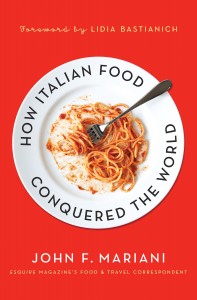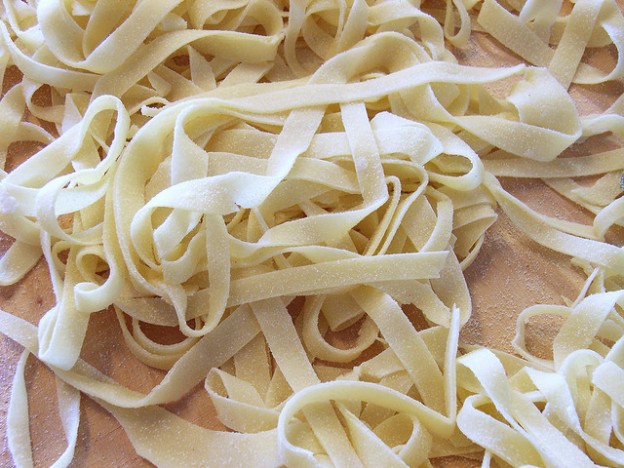Do you live or die for Italian food?
Many of us do, and our insatiable appetite for Mediterranean cuisine the way the Italians prepare it is a love story that spans generations. That love, understandably, has spawned myriad dishes — some iconic and lasting, others a flash in the proverbial pan — as each generation experiments with and interprets, replicates and enjoys, Italian food.
On Monday, June 13th, food and travel correspondent John Mariani will be in Boston to celebrate the publication of his new book, How Italian Food Conquered the World.
In anticipation of John’s presence at BiNA 0steria (details below), PRK caught up with him about dining Italian, both here in Boston and beyond. We wanted to hear his thoughts on what’s really new in Italian cuisine, and how Italian dining in the Boston area compares with other major US cities. Our interview appears in full after the jump.
But, wait! You can try your own hand at Italian cuisine with a recipe, below, for “Fresh Ricotta with English Peas, Mint & Lemon” from the chefs at BiNA osteria in downtown Boston. They’re hosting a special menu fisso this Monday evening, June 13th, in honor of Mariani’s presence at the restaurant and his new book. Call for reservations and more details (617-956-0888), but we’ll give you a taste here: Monday’s four-course meal includes taglierini and sheep’s milk sformato with native strawberries and grappa. Now, jump…

(Jacket Design: Jason Ramirez / Jacket Photograph: Tara Striano)
PRK: How would you characterize the Italian dining scene here in Boston?
Boston was a natural entry point for the wave of 5 million Italian immigrants (mostly from the South) from 1880-1920, so their influence on the local food culture became quickly apparent. The North End (see my answer below) was a tight enclave of Southern Italians but as the availability of first-rate ingredients from Italy arrived starting in the 1980s, Italian restaurants moved outward and became somewhat closer to the regional cuisines of Tuscany, Emilia-Romagna and the Veneto. Non-Italian restaurants, even places like Anthony’s Pier 4, began including pastas on their menus.
It’s interesting to note that when Bill Rice compiled Where to Eat in America (1977), the only two Italian restaurants recommended in Boston were Francesca’s and Felicia’s, both in the North End. By the time my own Mariani’s Coast-to-Coast Dining Guideappeared in 1986, contributor Steven Raichlen listed six Italian restaurants, including Davio’s, Allegro, Upstairs at the Pudding and Vin and Eddie’s. Since then, so many superior Italian restaurants have opened…that Boston can claim to be very strong in Italian.
PRK: What’s your perception of the North End? Where else in greater Boston would you head for good Italian food?
The North End, like NYC’s Little Italy, had for too long been so successful as a tourist destination that there was little reason to break from the tried-and-true traditional Italian-American formulas. Unfortunately, there was little impetus to use the best ingredients. That, since the 1990s, has changed, so that the North End restaurants balance their traditions with more personalized cooking with good ingredients. Right now in Boston, I am delighted to recommend places like BiNA osteria, Rialto, Il Casale, Scampo, Sorrelina, Sportello, Via Matta.
PRK: How does eating Italian in Boston differ from, say, New York, Chicago, or San Francisco?
Actually, aside from its own Little Italy, North Beach, San Francisco has played catch-up in Italian food after being so long under the influence of Provencal-Med food. Now the Italian restaurants there are becoming cookie-cutter pizzerias with pastas, all very loud, all very foodie intense. Chicago’s old-line Italian restaurants haven’t changed much at all, but a high-end place like Spiaggia is among the finest Italian restaurants in the USA. Otherwise, Chicago is in the grip of gastro-pub fever. NYC, of course, is as exciting a place for Italian food, as one can imagine, given its huge population if Italians, its tourist-driven resto industry, and the fact that people will pay top dollar to dine at places like Marea, SD26, Ai Fiori, and others. NYC is also richer in regional variety, e.g., Ligurian, Abruzzese, Roman, and Bologna-style restaurants.
PRK: What would you say to the home cook who doesn’t have much experience cooking Italian food, but wants to more often?
Stay as simple as possible and buy the best ingredients. A marinara sauce should not take more than 20 minutes to make. Spaghetti carbonara takes 10. Buy a good cookbook like Mary Ann Esposito’s or my own, The Italian-American Cookbook, and you’ll be surprised how simple, honest Italian cooking is.
How has Americans’ love affair with Italian food evolved over the past 15-20 years? What has caused that evolution?
Four factors: The importation (thanks FedEx and DHL!) of first-rate ingredients and the best Italian wines; the symbiotic connection of Italian food with Italian fashion and style, which created the perfect setting for casual dining; the advocacy of the Mediterranean Diet that showed Italian food to be exceptionally healthy; and the slew of first-rate Italian food shows on TV, including Mario Batali, Mary Ann Esposito and Lidia Bastianich.
What’s new, really new, in Italian cooking these days?
More stuffed pastas than ever—agnolotti, ravioli, tortellini, cappellacci; excellent breads; more emphasis on gutsy Italian food, [such as] tripe, meatballs, salume and braising. Pizza mania has already crested.
How DID Italian food conquer the world?
For 75 years, both in Italy and the USA, Italian food was always very very popular, even beloved, but still regarded as low class, greaser fare, and pizza was the lowest common denominator. For those four reasons I list above, Italian food has become ubiquitous, stylish, and by far Italian restaurants are opening with more frequency, including in Paris, Mumbai and Shanghai, than any other kind of cuisine.
Fresh Ricotta with English Peas, Mint & Lemon
enough for 8 to 10 servings
Courtesy of BiNA osteria
Ricotta
2 quarts whole milk
2 cups buttermilk
1. Line a wide sieve with cheesecloth, folded so that it is at least 3 layers thick. Place in a large bowl.
2. Put milk and buttermilk into a heavy-bottomed pot. Cook over high heat, stirring frequently. Occasionally scrape the bottom of pot to prevent it from burning
3. When mixture reaches 180 degrees on a candy thermometer, curds and whey will separate. Immediately turn off heat and gently ladle curds into sieve.
4. When all curds are in sieve and dripping has slowed (about 5 minutes), gently gather edges of cloth and twist to bring curds together; do not squeeze. Place in the refrigerator and chill for 15 minutes then discard the whey.
5. Untie cloth and pack ricotta into airtight containers. Refrigerate and use within one week.
Makes about 1 quart
Chive oil
2 bunches fresh chives
1 cup extra-virgin olive oil
1/4 teaspoon salt
1.Bring a small saucepan of water to a boil. Add the chives and blanch for 10 seconds. Drain and transfer to an ice bath.
2. Remove and pat dry on paper towels, squeezing to remove as much of the excess water as possible.
3. Roughly chop and transfer to a blender. With the machine running, add the oil and salt through the feed tube and process until smooth.
Transfer to a bowl and refrigerate overnight.
4.Strain through a fine mesh strainer, pressing against the solids with the back of a spoon to extract as much oil as possible
Warmed peas
4 lbs fresh English peas
3 tblsp fresh lemon juice
1 small garlic clove, thinly sliced
6 mint leaves, torn
chive oil
kosher salt, to taste
black pepper, to taste
1.blanch the peas in their pods in salted boiling water for 1 ½ to 2 minutes
2. transfer peas to ice water to stop the cooking process
3. once cool remove the peas from their pods
4. in a pot gently warm the chive oil then add the sliced garlic, mint & peas
5. take off the heat and add the lemon juice, season with salt and pepper and stir to combine
6. place the ricotta in a large bowl and make a well in the centeer
7. spoon the peas over the ricotta while still warm and serve the sea salt and sliced toasted baguette on the side
Other ingredients
Toasted baguette sliced
Sea salt


I am looking forward to this event! Great interview.
Unfortunately, I have yet to eat at an Italian restaurant in the United States, in any state, that had even a modicum of authenticity. I have NEVER, not once, been able to have pasta prepared “al dente” by any Italian restaurant. Most of the so called Italian food found in U.S. restaurants, pasta dishes in particular, are abominations. In Italy they would burn them down. Sad.